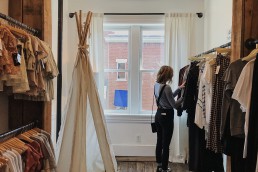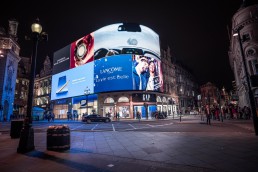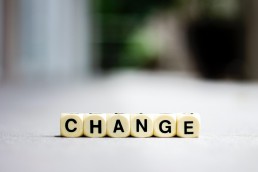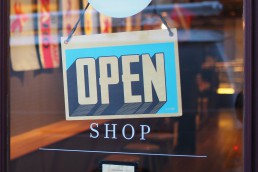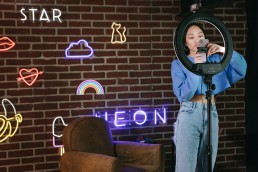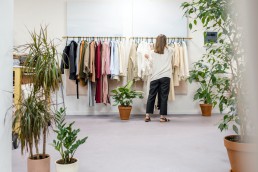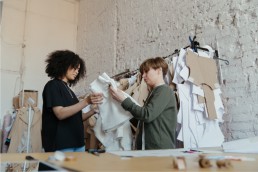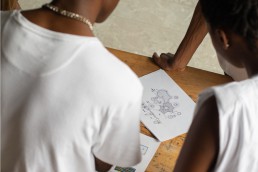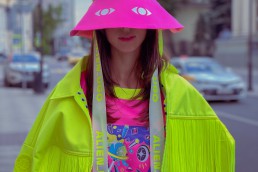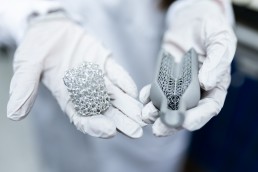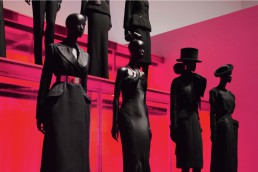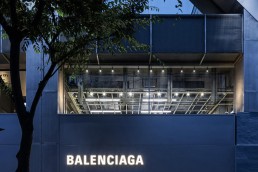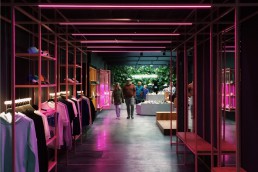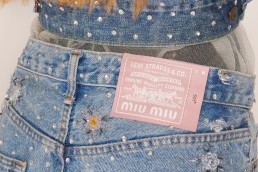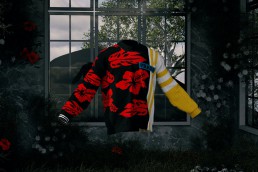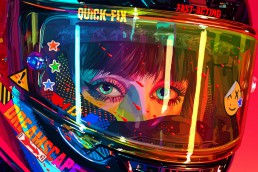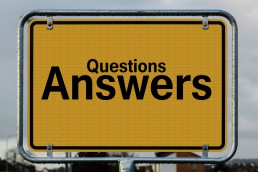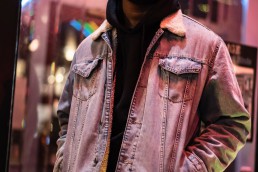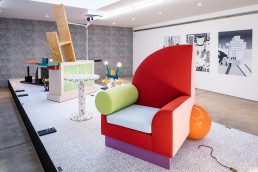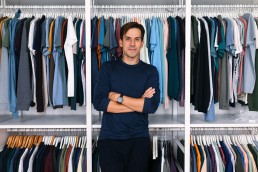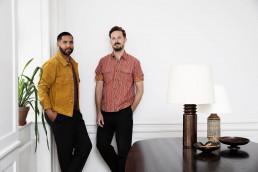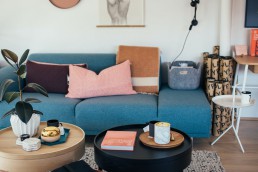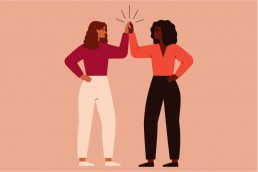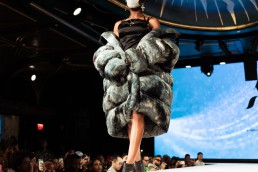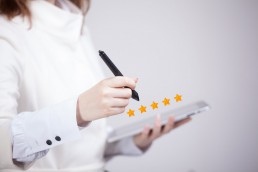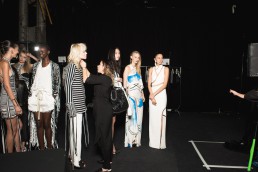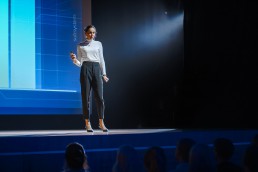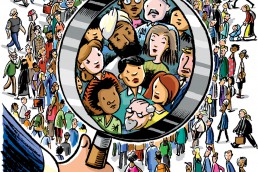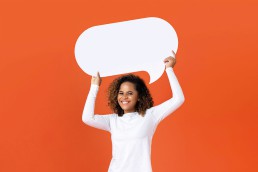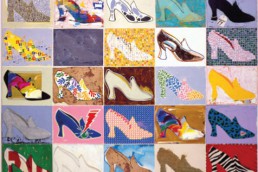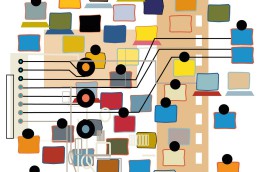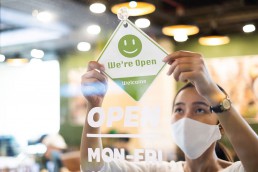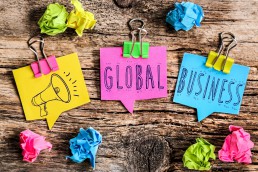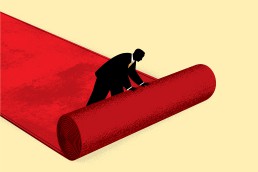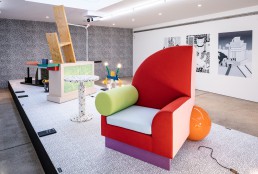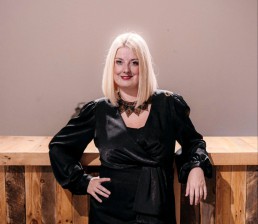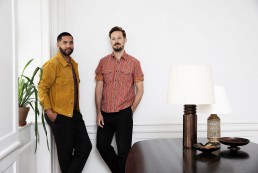Have You Heard About Memphis Design? The Group Celebrates 40 Years!
Memphis Design has a colorful aesthetic, a turbulent mix of elegance, kitsch, and subverted the industrial production of the time, a postmodern design approach that plays with irrational shapes, creating a cultural movement that stands until today.
Memphis-Milano was born in a living room gathering in 1980. A talented group of young designers and architects, led by architect Ettore Sottsass, were listening to “Stuck Inside of Mobile with the Memphis Blues Again” by Bob Dylan playing over and over again, and the legend was born. The Memphis name was an homage to Elvis Presley’s and Aretha Franklin’s roots in Tennessee and the pharaohs’ city.
Their first collection of 55 products under Sottsass and Artistic Director Barbara Radice, was presented in Milan back in 1981 at the Arc ’74 showroom of Brunella and Mario Godani at number 2 Corso Europa. It was an instant hit, because of its particular new language, and the use of plastic laminates with unexpected patterns simulating noble materials.
The first Memphis-Milano period with designers such as Ettore Sottsass, Aldo Cibic, Matteo Thun, Marco Zanini, Martine Bedin, Michele De Lucchi, Nathalie Du Pasquier, and George Sowden, changed the way people perceived objects and furniture, gathering international attention by an avid clientele and the press.
Andrea Branzi, Alessandro Mendini, Michael Graves, Hans Hollein, Shirō Kuramata, Peter Shire, Masanori Umeda, Arata Isozaki, Terry Jones, Javier Mariscal, Paola Navone, Luigi Serafini, and Bruno Gregori from Studio Alchimia also displayed in this legendary debut.
An Interior Design Legend: Why Memphis Is Still a Source for Inspiration
Forty years later, some of their pieces are still produced in unlimited series in the belief that “design should be understood as a means of communication and not as an expression of elitist art”.
The late fashion designer Karl Lagerfeld was one of the main enthusiasts of the collective. It is well-known that back in 1983, Lagerfeld’s private apartment in Monaco was fully decorated with Memphis group pieces such as the iconic large boxing-ring by Japanese designer Masanori Umeda, as well as desks, chairs, and contemporary furniture of primary colors that he described as “Frankfurt hotel concierge furniture” according to author Alicia Drake in The Beautiful Fall.
Memphis Milano continues to influence the global conversation and feeds, to some degree, references of pop culture, from fashion to television and music; a place of inspiration where all fashion designers, architects, interior designers, or industrial designers can always return to due its importance and its relevance.
The group was, in a way, pioneering some current topics of forty years ago, such as the social function of design and furnishing, the production value chain and its economic impact, and the playful limits of aesthetics to celebrate the banal and common objects conceptually questioning “the good taste”, a term that was also attributed to Yves Saint Laurent in the 1970s for disturbing the discreet charm of the bourgeoisie.
From May 19 to June 23, Creative Director Anthony Vaccarello hosted an exposition in both Saint Laurent Rive Droite stores in Paris and Los Angeles, showcasing the history and works of Memphis. The brand displayed a large selection of books, homeware pieces, ceramic objects, and textile accessories (ashtrays, vases, plates, glasses, decorations, and textile accessories including pouches and scarves), paying it a tribute.
Memphis Group: Interior Design Innovators
The design group’s aim was “to overcome the dictates of functionalism…and its design philosophy was influenced by the emergence of the information society”
Memphis: 40 Years of Kitsch and Elegance, is the ultimate exhibition at the Vitra Design Museum Gallery celebrating the fortieth anniversary of the group’s foundation through its creations, presenting furniture, lamps, bowls, drawings, sketches, and photographs that give insight into the world of Memphis. The exhibition will be open until 23 January 2022 in Weil am Rhein, Germany, and it is curated by Dr. Mateo Kries.
Similarly to television and computers, Memphis objects were meant to communicate with the viewer and tell their own unique story. As the initial comic book, they created a new look and set new standards in which popular culture, advertising aesthetics, and postmodernism merged in a crazy medley.
“Memphis was started with the idea of changing the face of international design, and it chose the most effective, direct, and hazardous way to do so”, stated Barbara Radice, Founder, Design Critic, and Publisher of several books around the contribution of Memphis group. She always wanted to show the group had an intellectual basis whose energy and creative drive had lost none of their fascinations.
Memphis-Milano, a definitive inspiration for the current and the future interior designer generation.
Fernando Aguileta de la Garza
Who Do You Need to Hire to Lead in the Digital Boom?
According to J.P. Morgan’s article: The Next Normal Arrives, Trends that Will Define 2021 and Beyond, we are in the year of transition in which businesses and society start to look forward to shaping their futures. This future is digital, for the last 18 months the acceleration in the use of technology, digitalization and new forms of working allowed companies to move 20 to 25 times faster.
Mckinsey’s survey, “How COVID-19 has pushed companies over the technology tipping point—and transformed business forever”, found that companies are three times more likely than they were before the crisis to conduct at least 80% of their customers’ interactions digitally. So if you have not done it yet, now is the time to build or reinforce your team with digital capabilities.
Talent becomes crucial to thrive, move from reacting to the crisis into building what will work in the foreseeable future. You will need a combination of technical and business capabilities, depending on the size of the challenge you are trying to solve.
If this is the first time the business will be having a digital team you might consider the “Minimum Viable Team” concept, which is an adaptation of the “Minimum Viable Product” from the Lean Startup Methodology: start building with the smallest form of your desired team, get experience, and then grow bigger.
Technical Team
Either if it is an external provider or an in-house hire there are at least three core roles needed to build a viable digital platform:
Back-End Developer: You need a qualified developer who can deploy new applications or sites to expand your digital properties and solve database challenges or workflows to meet the needs of new processes or implementations. They will also be responsible for enforcing cybersecurity standards to protect the integrity of the systems, a feature that is even more important if your site has an e-commerce platform or you manage user data.
Front-End Developer: This role is in charge of selecting frameworks and coding standards for the technologies that will be used, HTML, HTML5, mobile etc. It is important that both back and front end work together to make sure that the full user experience can be implemented.
Data Analyst: This role entails being In charge of developing the specific data models and plans for data management. Data Analysts are also crucial to keep your databases “clean and healthy” evaluating periodically if there is something wrong. It is a role in high demand due to the need to build up analytics capabilities at a rapid pace to meet the boom in e-commerce, growth hacking, etc. IDC forecasts that big data and analytics software revenue will reach $66.8 billion dollars in 2021.
Digital Business Team
UX Researcher-Designer: This person is the one with a sixth sense – based on research and experience- to really understand the audiences that will be using the site, digital products or services. The UX team has to work side by side with front end developers to create a customer experience that translates into sales. Linkedin listed UX design as one of the Top 20 skills to learn in 2020, and since we are spending more time online, the need for these professionals will continue to grow.
Digital Marketing Strategist: Growth and lead generation are two of the most important things a digital marketer offers to the business. To do so, this role chooses between social media, content marketing, pay-per-click, email marketing, social ads, and many other strategic paths. Your business will definitely benefit from a strategist that makes the most of the growing opportunities, considering that according to the Datareportal report, Digital 2021 Global Overview, there are trillions of dollars spent on e-commerce around the world, and more than 1.3 million new users joined social media every day during 2020.
SEO Expert or Content Developer: Trends like shoppable posts, video marketing, and interactive content require someone who knows how to work with the algorithm, and create compelling stories that combine brand identity with customer needs.
Not unlike any team, it is important to create well-defined responsibilities and processes to get them organized in the most effective manner. Remember to hire considering alignment with the purpose, objectives, and general business strategy of your company as well as looking for balanced talents.
María Mercedes Baltazar
Join the Conscious Fashion and Lifestyle Network: A Conversation with Kerry Bannigan and Megan McAstocker, Founder and Partnerships Manager
An insightful conversation with Kerry Bannigan and Megan McAstocker, from the Conscious Fashion and Lifestyle Network, about the importance of partnerships and open connections inside the fashion industry, and how advocacy, education, and engagement on sustainability can change the future.
The Conscious Fashion Campaign, in collaboration with the United Nations Office for Partnerships, is accelerating global fashion industry action in support of the Sustainable Development Goals (SDGs).
Last month, as part of phase two, they launched the Conscious Fashion and Lifestyle Network, to engage creative sectors in support of the goals and COVID-19 response and recovery. The network is an online platform for industry stakeholders, governments, and NGOs to showcase actions, report progress, and share solutions accelerating the contribution of the fashion industry sector to reaching the SDGs by 2030.
“The Conscious Fashion and Lifestyle Network offers an opportunity to cultivate an innovative and essential community of practice to help deliver sustainable change in the Decade of Action” states Annemarie Hou, Acting Executive Director at the UN Office for Partnerships, as it allows industry leaders to set a valuable example for sharing and openly discussing their experiences and projects.
Current partnerships include Fashion4Development, Lenzing, Mara Hoffman Renewed, Messe Frankfurt Texpertise Network, Queen of Raw, Red Carpet Green Dress, Redress, and Swarovski Waterschool, to name a few projects inside the network.
This innovative approach to collaboration comes from the mind of Kerry Bannigan, a British Social Entrepreneur, Advocate, and Advisor pioneering global fashion and media initiatives to accelerate transformative action for social, economic, and environmental change.
Bannigan is a founding member and Executive Producer of the SDG Media Zone and the President of the Board at the PVBLIC Foundation. Her portfolio spans over fourteen years of purpose-driven programming, event production, and high-level partnerships with brands, government, and United Nations agencies.
Also part of this initiative is Megan McAstocker, the Partnerships Manager for the Conscious Fashion Campaign. Her experience in the fashion and social impact industries spans over eight years, with a background in marketing, event production, social media, and partnerships. McAstocker, currently also serves as the Event Producer for the SDG Media Zone.

Interviewer: What are the greatest accomplishments of the Conscious Fashion Campaign during its different phases, from the beginning to the launching of the network?
Megan McAstocker: Each milestone we have accomplished with the Conscious Fashion Campaign has been equally exciting to us. From our pilot event in 2018 during the Partnership Expo, hosted by United Nations Agencies aboard the Peace Boat, the world’s largest passenger ship sailing around the world for peace, sustainability, and innovation, to the successful launch of the Conscious Fashion and Lifestyle Network last month.
A standout moment for us includes the launch of Sustainability by Design: Rethinking NYFW, a study featuring a comprehensive Executive Summary and Report focused on the environmental impact of New York Fashion Week alongside Boston Consulting Group, and the Council of Fashion Designers of America (CFDA).
In December 2020 we worked with the British Fashion Council to align their Fashion Awards 2020 Honourees with a Sustainable Development Goal to reflect their positive change leadership. Over 800 key members of the international fashion industry were called upon to nominate whom they thought should receive an accolade. The awards were presented by: Priyanka Chopra Jonas, Lewis Hamilton, Aja Barber, Maisie Williams, and Rosalía.
I: In an industry as “closed” as fashion, why do you advocate that collaboration and partnerships are the keys to a paradigm shift?
MM: In the wake of the COVID-19 pandemic, partnerships and collaboration within the fashion industry are more important than ever. The fashion industry is a $2 trillion industry that employs more than 60 million people globally and has the potential to make an exponential change. We are at a crucial moment in history, the SDGs remain the framework for recovering better together, collaboration and partnerships ensure an inclusive and resilient future for not only our industry but for people and the planet. Partnerships will be crucial to leverage interlinkages between the SDGs and the future of the industry.
I: How do you encourage businesses and brands to join the network? Why does their commitment matter, and will being transparent about it build long-term connections according to your philosophy?
Kerry Bannigan: Businesses and brands are encouraged to join the network via our industry partnerships and digital community. Given its global reach, the fashion and lifestyle industries are uniquely positioned to collaborate and engage on the Sustainable Development Goals, especially as they confront the climate crisis and ensure a resilient post-pandemic recovery. Systemic change must be given precedence across the value chain. The Conscious Fashion and Lifestyle Network has been launched for industry stakeholders, governments, and NGOs to openly report ongoing progress and share solutions, thereby accelerating the sector’s contribution to delivering the goals. The collaborative community of practice aims to drive innovation, connect industry leaders, facilitate new partnerships and enact sustainable change.
How to Join the Network:
- Go to the official website of Partnerships for The SDGs, A Global Registry of Voluntary Commitments and Multi-Stakeholder Partnerships, to register your initiative.
- Previously collect key information involving the initiative to fill-up the application, such as title, active partners inside the commitment, location.
- Select which Sustainable Development Goals and Targets you are committed to. Think of realistically achievable objectives according to your organization, brand, or community.
- Provide details about the project; you have to be as clear as possible about coordination mechanisms, implementation methodologies, arrangements for capacity-building and technology transfer, completion date, and website to look at for more information regarding the initiative.
- Add tangible deliverables including the final delivery with concrete dates, and the resources that are devoted to this initiative. Do not forget to share contact details and private comments for the UN secretariat.
- Engage with other’s goals, partnerships, and achievements. You can learn from their experience and encourage open innovation.
I: Once they have registered, how do you follow their progress on commitments? And how can affiliates engage with each other to collaborate?
KB: Registered initiatives should show an ongoing concrete contribution to the implementation of the Sustainable Development Goals and the objectives of the network, respect the principles of the United Nations and follow the SMART criteria – being Specific, Measurable, Achievable, Resource-based with Time-based deliverables. The voluntary commitments are reviewed periodically. Registered initiatives are invited to offer insights at think tanks, access to speaking opportunities, and invitations to future events. Additionally, contact details are openly available for initiative representatives to connect as well as attend hosted roundtables, workshops, and convenings.
What Are the Communities of Practice?
According to Etienne and Beverly Wenger-Trayner, top researchers in this field, Communities of Practice are defined as, “groups of people who share a concern or a passion for something they do and learn how to do it better as they interact regularly”. This concept brings a useful perspective regarding knowledge and learning. A lot of organizations in transversal sectors are focusing on its value as it is “a key to improve their performance”.
A community of practice is dynamic and involves learning on the part of everyone. We can find it in government, education, associations, the social sector, international development, and the Web.
To constitute a real Community of Practice, three characteristics are crucial:
- The Domain: It has to be clear the main domain of interest. The members are involved in the commitment, “and therefore a shared competence that distinguishes members from other people”.
- The Community: The members must build relationships that enable them to learn from each other. They care about their role and interactions, “members engage in joint activities and discussions, help each other, and share information”.
- The Practice: Above all, members of the community of practice are practitioners. It is not only a community of interest who likes a certain topic. The interaction and practice, as in all communities, takes time. However, in the long term, “they develop a shared repertoire of resources: experiences, stories, tools, ways of addressing recurring problems-in short a shared practice”.
I: In terms of education programs, what are your future activities? What are the main principles to educate regarding the Sustainable Development Goals inside brands, projects, or businesses?
KB: We have a series of educational and knowledge sharing activities planned to range from global digital to regional in-person; including New York Fashion Week, London Fashion Week, and United Nations General Assembly. Our work is built on advocacy, education, and engagement – all as key core pillars to strengthen industry engagement of the Sustainable Development Goals by showcasing best practices and connecting United Nations representatives with industry stakeholders to show the implementation of the Goals within the business.
Fernando Aguileta de la Garza
How to Create Consistent Brand Communications
To understand the integrated communication approach, we need to know the main areas of action where to build the brand’s communication strategy. Today we share practical aspects and tools for fashion and lifestyle businesses.
A brand must have a communications roadmap to fulfill its purpose, a systematic message and appropriate tone aiming to connect with customers building awareness in the long-term. Communication frameworks are essential to integrate all possible tools to release our brand’s message.
Communications are related to sales, however, sales are not their primary objective. When we think about action, leads, and tactics, we are talking about marketing. When we deal with reputation, perception, and dialogue, that is communications’ territory. Each of them requires our attention and creativity to get the best from both worlds.
“Phygital” strategies, employer branding, transmedia, and corporate social responsibility activities, have become crucial pillars to develop a significant and coherent global brand message. If we build our brand communication according to immediate results, we are starting with the wrong foot.
Communication Strategy and the Brand’s Value Equation
Branding and business identity are beyond daily communication activities. It requires top management involvement to shape and determine a brand’s expression and tone according to the values and the brand’s personality. It is a change of perspective from a traditional communications point of view. If we see the brand as a financial asset – the most important intangible to preserve- investing on it and creating a network of influence will increase brand’s value, whether might be through brand culture or brand’s associations.
For example, according to Statista, Chanel’s brand value amounted to “13.7B US dollars, an increase of more than two billion in the previous year”, a great performance for the French luxury brand despite the pandemic, and a strong proof of a distinctive style (some of it under trademark) that is paying off.
Another case of significant brand value related to a communications strategy, is Tiffany & Co., LVMH’s latest acquisition for an amount of 14.7B Euros. The transaction included intangible assets which are essential to the core business. For instance, colour trademark, an item included in the 5.8B US dollars brand valuation, according to Brand Finance.
For Tiffany & Co. “the iconic robin’s-egg blue hue known around the world today as Tiffany Blue® has been synonymous with the luxury house since the iconic Tiffany Blue Box® debuted”. The colour, “1837 Blue,” named after Tiffany’s founding year is a fundamental part of the brand, as well as its communication strategy. As stated by The Fashion Law “it is undeniable that the colour has played an integral role in helping Tiffany & Co. to achieve the status of one of the valuable jewellery brands in the world…Tiffany has not only “monopolized” a colour for itself, as many publications assert, but has monetized it in a big way”.
Brand Communication Areas: Tools and Activities to Deliver Our Message
A practical brand’s framework regarding the integrated communication approach is useful to oversee and to have “the big picture”. Below you can find seven areas of action where you can apply ideas to in order to set up a strategy:
- Corporate Communications: all communication efforts are about the brand explaining itself. Think about creating an “About Us” page, crafting a particular brand story to tell, designing Corporate Social Responsible activities, creating a communication campaign through brand values and personality. Cartier for example, has created well-remembered video campaigns regarding its heritage.
- Product Stories & Services: in fashion, the product itself communicates a lot. You can communicate the collection development, inspiration, product attributes, product services or benefits, customers want practical information. Think of Stella McCartney’s vegan leather made in partnership with Mylo Unleather; the firm developed an alternative material to leather made from mycelium (the roots of mushrooms), essential information to communicate.
- Traditional Promotion: any brand can rely on classical tools for communication, such as, advertising, point of purchase materials, visual merchandising, and runways. Having new channels does not mean traditional ones will no longer work. Tangible events are what clients are waiting for, besides getting back to stores to live an experience.
- Press and PR: dealing with magazines and online media outlets in our strategy can bring status and reinforce our brand positioning. If we develop newsworthy editorial content or information, and partner with the right channels, we will be able to build a strong reputation that will serve the brand’s interest. PR can be a smart tool, using key people relationships, making celebrity endorsements, giving wardrobe loans and setting ambassadors, can all make our brand desirable for the audience.
- Social Media: a field in a constant transformation and evolution. The social media landscape integrates the best way to reach our client base closely. It gives us the capacity to listen to what they are saying, what they want, what they care about. Whether it is by text, photo, video, giveaway, ephemeral content, engaging with communities, it is mandatory for any brand in the digital age. Think of the Telfar social media channels. Designer Telfar Clemens created a strong bond with the African-American community in New York through social media campaigns and star products; his number one hit “The Telfar Bag”, or “The Bushwick Birkin” as the press has dubbed it, always sold out.
The consistent brand communication approach used effectively and efficiently, can deliver a wide range of positive outcomes. Integrating tools and messages across the communications strategy strengthens its position, and serves its purpose in a holistic way. Brands and strategists must prepare for a more integrated future.
Fernando Aguileta de la Garza
The Value of Social Listening: Insights, Prevention, and Connection.
Once upon a time a marketing and communication strategist had to look outwards to try to figure out what their customers were thinking, feeling or believing about their brand. As our environment became more digital, social media allowed us not only to open more communication channels, but to understand our audience’s perceptions and values by doing something as simple as listening.
Don’t get me wrong, I understand that social listening has a certain level of complexity, but learning how to do it delivers valuable insights about our market, competitors, audience, and the performance of our content. It also improves our capabilities to prevent incidents or crises that could damage the reputation of our brand.
It is possible to know the pulse of the conversations around our brand in real- time, in addition to the the impact of our owned, paid, and earned media, to discover which concepts or companies have a shared interest with us, and even understand the needs we haven’t met by listening to what our audiences have to say. They are constantly leaving hints through their digital behaviour, and we must incorporate tools to analyze the conversations and translate them into actions.
There are several options in the market, from free tools to sophisticated software with AI. Choosing the best for you depends on the maturity level of your company, the purpose, and the metrics that will be considered. My recommendation, based on personal experience, and the data presented by Statista, is to have more than one listening solution.
According to a survey carried out by Statista in 2019, 56% of responding public relations professionals from Colombia, Mexico, and Venezuela said they used more than one social listening tool, because the tools used different data sources and tested different capabilities.
Beyond monitoring the performance of your digital campaigns, listening tools can contribute to the decision making process of the leadership team, it doesn’t matter if you are a designer who is building a new brand or an international fashion company, it is important to know what is happening outside your chamber of echo.
How to Add Value to Your Social Listening Habits:
- Find Insights
Trend analysis on emerging themes is the most used feature for PR professionals in Latin America. According to Statista’s survey, this information by itself might not make a difference, but with the proper analysis creates a broader spectrum of possibilities, and also challenges your messaging, actions and plans. There are signs preceding every major change or emerging issue, the opportunity relies on those who take the time to notice them.
These insights have a much deeper impact than just adjusting your social media strategy, they might help you reset your business strategy, alliances or even expansion plans.
For example, Socialbakers’ report Retail In Latin America, shows that retail is the category with more Facebook interactions in the region, similarly, on Instagram we find that fashion, e-commerce, and retail are the top three categories. The same report finds that on both platforms,live videos are the type of content with more organic engagement. If we consider an additional layer of data, such as the most used words in your category or sentiment, we start to dig deeper and create new links.
- Protect and Enhance Reputation.
Reputation is one of the most valuable assets for a company, it doesn’t matter if it’s a luxury company or an independent custom-made brand. It takes a lot of time, consistency, and intention to create a good reputation, and only one mishandled crisis to tear it down.
Social listening is crucial to prevent incidents, since it sets alerts for controversial conversations and crisis management in times when it’s crucial to communicate, contain, and counteract. I remember several cases in Mexico, where retail brands were in the middle of a crisis that could have been handled better if they had a preventive approach to listening.
In times where controversy and trolling are part of our daily occurrence, it’s also important to be able to identify if the negative conversations come from real profiles or if it’s part of some sort of campaign. This sets the tone of the messaging strategy, resolution plan, and future actions.
- Create Better Connections
Do you remember Mel Gibson’s movie What a Girl Wants? The main character creates an extraordinary ad campaign after getting the super power of reading female minds. Making a pretty basic analogy, we might consider social listening to be the transformation of that super power into a technological solution.
Our success depends on how much we create valuable connections with our audience. They want to hear from us, but they want us to be socially aware, to have consistent values, to give back to the community, to become agents of change. How do I know that? By listening to what their conversations, shares, likes, are saying to me.
Industry reports are quite helpful, however, if you set up a daily, weekly or monthly habit of analyzing the valuable information inside the listening platforms of your choice, you don’t have to wait until they are published. Set up the keywords, accounts, topics,and time frame you are interested in and start doing the next best thing to reading minds.
Maria Mercedes Baltazar
Case Study - Son of A Tailor
Son of a Tailor is known as a custom-clothing company. But, the startup is also a forward-thinking business sitting at the intersection of technology, design, and environmental strategy, which uses innovation as a core process in aim to eliminate waste in the clothing production.
It was launched in 2014 as a Kickstarter campaign with a single approach: to produce high quality t-shirts. Nowadays, the startup offers a range of essentials for the contemporary man.
Son of a Tailor is co-founded by Jess Fleischer and Andreas Langhorn, both with complementary backgrounds. Fleischer is a former engineer, whose professional journey includes eBay and consulting firm Booz & Co, with 10 years of experience in supply chain and Lean manufacturing; Langhorn, on the other hand is an art director professional, a founding partner of visual media production house Star Athlete Music & Sound Design, that specialises in visual media content across digital platforms with clients such as Nike and Microsoft.
The core spirit of Son of a Tailor is born out of the frustration with wasteful production approaches, a lack of quality and fit in garments, and a deep customer dissatisfaction.
Son of a Tailor has built an online platform and developed a precise algorithm to easily make a unique tailored range of garments by merging technology, and a smart supply chain. Its aim is to take care of everyone involved; the people who produce it, the people who wear it, and to improve the industrial process itself to meet sustainable goals.
The company is a venture-backed start-up with existing investors such as, Founders, InQvation, Thomas Ryge, and Morten Strunge. Last year, the Copenhagen-based start-up received 7M USD investment from eEquity, a leading digital growth investor, to drive change in the fashion industry’s supply chain.
This new positive landscape arrives with the profitability of the brand, despite the Covid-19 outlook, the startup has doubled its customer base and sales in 2020 while creating value for its customers, and doing things differently from the traditional fashion massive production model.
“I see this as proof that investors recognise the massive customer response to our agenda of fundamentally changing the fashion industry” Jess Fleischer, Co-Founder of Son of a Tailor
The new capital will strengthen its position as a global leader in made-to-order clothing, besides making further investments in production. Jörgen Andersson, a former H&M and Uniqlo executive brand and marketing director, joined Son of a Tailor’s Board of Directors, supervising the company’s mission to revolutionize the supply chain in fashion.
Do you want to read more? Please fill your email below and we will send it to you!
Fernando Aguileta de la Garza(ELLE Business)
Responsible Businesses, A Conversation with Frederik Larsen, Consultant and Academic Researcher
An insightful conversation with PhD Frederik Larsen, co-founder of Infuturum, about his career as a researcher on fashion, sustainable business practices, design, second-hand markets, and strategic consultancy; helping organizations to prepare for a just and sustainable future.
A path towards sustainability is a long-term approach, however, it demands immediate actions to reach the final goal. A diffuse perspective for some businesses who that want to get into the action, though do not know where, and how to start.
The compulsiveness of the current fashion system is an end-road, a systemic change is mandatory in order to build new ways of doing business. This purpose is rooted at strategic consultancy, In Futurum, founded by Frederik Larsen and Moussa Mchangama. A tandem with complementary backgrounds, advising companies and brands on how to be sustainable in an effective and clear way.
Their method is to create strategies in a research-based scenario, finding valuable knowledge that can drive immediate change. Additionally, they make an analysis to improve all business processes, and communication inside and outside of the company.
Recently, they published the report, New Ways for Responsible Business: Sustainable Fashion in Action: a study covering business models and sustainability practices in Scandinavian fashion companies, with significant conclusions and insights about key elements for mapping strategies inside companies, and frameworks to work with.
Mchangama, is MA in Modern Culture & Communications from The University of Copenhagen, he has spent the last decade combining writing, critique, branding and concept development with social activism. Larsen, holds a PhD from the Copenhagen Business School in Organizational Anthropology, does academic research and has worked with responsible businesses for a decade.
Interviewer: What are the essential topics to develop a real sustainable mindset into a fashion or lifestyle business?
Frederik Larsen: The work we did for Copenhagen Fashion Week reflects a lot of those concepts that we have worked with. There has been a tendency to focus on one area;that can be a good place to start for a lot of fashion and lifestyle businesses, for example, areas can include materials, textiles or plastic use.
We wanted to unfold or to open up the discussion to all different areas that are necessary, and with the focus on the technical side of sustainability.
A lot of brands, fashion designers, and companies tend to think that everything is about what you can measure, and how you can lower your carbon emission, for example, it is part of the picture for sure, but if we do not start talking about consumption, if we do not talk about design, if we do not talk about lifestyles and strategy when we are in a business setting, things will not change fundamentally.
Therefore, we have to approach it from a much more holistic point of view. It is about the environmental aspects; it is about from technical solutions, to technical problems, and cultural problems as well, about consumption levels.
Sustainability has to do with the way we think about business. This paradigm of focusing on economic growth as the main driver of innovation and development, has to change. What we are proposing is not in opposition to creating a solid economy or a solid company, it is about changing the mindset.
The simple focus on economic growth limits what you can do in terms of creating a new set of products and innovation, as well as in terms of reaching your audience. Nevertheless, we do see many companies focusing exclusively on environmental sustainability, and overlooking the fact that there is also a huge social aspect within, such as consumption and fair wages, especially in the fashion industry.
“It all comes down to looking at the big picture, and that essentially means to understand that there is an environmental sustainability side, an economic sustainability side and a social side inside of the companies”
I: As an advisor, what is the roadmap to start in the right path of change? What would you recommend for mapping sustainable practices?
FL: You always have to begin where you have the most impact and where you have the most control, basically. We do help companies map out what they actually do. Smaller companies, for instance, know what is happening inside the business itself and in their own offices. However, for a lot of them, it is very difficult to get access or to understand what is the entire impact they have across the whole supply chain or consumption.
We, as a consultancy, tend to focus on strategy, on business development, on design itself, on sourcing, and on communicating your efforts to your customers. It is very simple, but it is very effective.
There are a lot of things you cannot control, especially as a small company. That does not mean that you cannot have an impact in the market, or that you cannot change how you -as a brand- engage with these areas.
We always create a link between what drives the company and the people inside the brand, such as employees and the owners. Because it is very difficult to create change if it is not aligned with coherent values and the way you do business. A lot of them tend to be more marketing-oriented.
Brands must engage everyone inside the company. Ask questions such as, how can we build or create something that takes better care of the materials that we as a company use? Or make sure that the work environments are safe throughout the production, for example.
New Ways for Responsible Business: Sustainable Fashion in Action: a study covering business models and sustainability practices in Scandinavian fashion companies
For mapping sustainability in action, companies must address four main areas of impact and integrate this practice as a core part of its strategy: Production Control, Design and Anti-Consumption, Materials and Impact, Longevity and Knowledge Sharing.
Some actions for change, according to the report, are to tackle consumption, create decent job opportunities, get rid of synthetic materials and create new business models based on a holistic perspective “Understanding how environmental, social and economic challenges are interconnected is necessary to set a direction”.
That perspective includes rethinking fashion business from another point of view, “re-establish true value in the products and in the business model itself”, creating responsible investments as “financial interests are often at odds with sustainability efforts”, and aims to change the “business as usual” way of producing things.
For that goal, it is mandatory to understand the full life cycle, how we produce and what would happen in time with this product? In that sense, a purposeful use of technology can take an important part of the process helping technically and socially. A full integration of tools to build resilient business structures “to cope with the volatility, by creating stronger relationships across the value chain”.
I: Your findings (in the report) portray a certain daily basis for Scandinavian brands, do you think some of them could be extrapolated to other realities?
FL: It is very nice to see that some of the insights we have collected and the analysis we have done has gained attention from brands globally, actually. We have been working with these Scandinavian companies in this context, but it could have been other companies.
Most of the brands are international, in the sense that their products are sold globally. However, this is not about “a Scandinavian way” of doing anything. It is about the everyday activities within these companies, so hopefully it reflects a lot of what people do.
We wanted to portray that the challenges that they have are very similar in a lot of different companies. The main purpose of doing this research was, in fact, to start sharing.
In the research, there are some examples of successful practices, some others about the difficult stages. Hopefully others can use that to be braver in terms of setting actions. Also, it is relevant to talk about what brands are doing, even though not all actions are perfect and even though it is not at full capacity in terms of what their goals are.
“I definitely believe that there are a lot of approaches and the way different brands work with sustainability initiatives or with sustainability strategies can be influential, inspirational, to others”
I: What must brands -big and small- learn to start thinking from this holistic perspective? Is the fashion system really rebooting? Are the challenges equal for all?
FL: It is an interesting question, as we often hear from smaller companies that the big ones can do the transformation because they have enough money, or the funds for it, and they can make a global impact; and then, on the other side, we hear from the bigger companies-“Oh! It is so difficult to change! small brands have it easier”. There is always a “it-is more difficult-for-us-than-for-others” response, I think that is a general thing, we tend to compare ourselves to others without realising how challenging it is for them as well.
One of the main points, in terms of the global fashion industry, is that the growth we have seen in the last years and the global expansion that seems to be growing continuously, is unsustainable in itself.
That kind of growth has been driven by the push of the fast fashion structures, to be implemented almost across the board, no matter the size or the type of company. This has created a pace, in terms of timing and trends, that translates into pressuring prices. Those pressures just moved further down the supply chain, which is affecting billions of people globally. All of this has to change.
I believe that we could start by looking at how the fashion industry has changed already. That is one of the points we are trying to get across as well. Creating a change is very difficult, I acknowledge that, but it has changed enormously in the last 20 years, and especially the last 10 years.
“The Fashion Industry can change again we want it to, that is the first thing. Do people want to show that they are doing something? Or are they actually making changes?”
I: You have written about second-hand markets, business practices and fashion to name a few topics in your doctoral thesis. How did you get into this field? What were your motivations as a researcher?
FL: I spent more than 10 years working in research in the social sciences, business management, and in the field of sustainability-broadly speaking- and fashion. I found this to be a place where you can look at industries from a human perspective; anthropology is very much focusing on human activity and culture, with an understanding that business is a world of its own.
There was a very small dedicated research group locally working on second-hand markets back then, and now, the subject has grown enormously. All fashion companies are looking into how we can create resale platforms, and extend the lifespan of their products, so, it is nice to see that the industry is getting there.
I focused on the second-hand markets, also outside of the fashion industry. What happens to products when there is no creation involved? How do you create value from products that basically start off as waste or trash? Do they then become something through problem solving or marketing?
We are using this holistic approach at In Futurum, in the sense of looking at the full lifecycle perspective of products are and saying: “it is not enough that we focus on how they perform in production”. We must also focus on the design phase, marketing, and specially, as soon as a consumer enters, put our attention at the end of the life cycle of products, as sometimes we do not know what happens to them.
The knowledge that came from doing academic research and publishing, have created the foundation for how we approach advising on sustainability, because I am not a natural scientist, but I am educated as a scientist, this allows me to look for the right kind of information, and know how to assess it. I think that perspective is so important, companies need to trust that if they do this, it will have a positive impact and they can base future decisions on that knowledge.
“The Fashion Industry has been quite under-researched for a long time. A lot of academics have looked upon Fashion as being too frivolous or unimportant to actually study”
I: In your point of view, what are the research areas in fashion and sustainability in the future?
FL: I do think that across a lot of different industries, including fashion, the intersection between people and technology is definitely something there is a lot of research on, however, a lot of it starts with the assumption that we need to figure out what technology can do for us. This common set up neglects the important question. It cannot do everything for us. What we are doing right now is trying to implement new technologies wherever possible, instead of looking at wherever is most necessary for the best.
How does it affect us? What can technology actually do to drive human development and interaction between people? To improve the quality of life, life circumstances, and health… Or to improve some of the existing horrible working conditions? Instead of focusing on how we can implement technology that makes it easier and faster for people to have access to consumer goods. I think that is a huge issue.
There has been a tendency to focus either on fashion as a cultural system or as a business. A lot has to do with representation and looking at the artistic and stylistic parts. The other side is about how the industry works. Those two are obviously connected, as technical and social representation coexist.
A huge area for research is waste management on textile waste. The amount of textile waste is staggering. We have to go all the way back to consumption, design, sourcing, into the material production and question the areas that are creating and accumulating all of this waste, analyse those areas, instead of just saying: “how can we recycle it?” Because that is clearly not the end of the problem.
As a conclusion, I think we need to focus on how to radically change the entire fashion system. We need to change the conventional understanding that fashion is about excluding people, and include everybody instead of trying to tell them that they are not good enough.
That systemic change is what we need right now. Understanding the cultural and social aspects, and combining that with a deep knowledge that is research-based, this is important to bring things forward.
Fernando Aguileta de la Garza
Lessons From The Boom of Creator Economy: Build a Community for Your Brand
Alternative revenue streams emerged as a response to uncertain times, from regular people turning their passions and interests in a career, to celebrities, designers and artists finding different channels to monetize their work. I’m talking about the creator economy.
It is defined as: the class of business built over 50 million independent content creators, curators and community builders, plus the software and finance tools designed to help them with growth and monetization. According to the venture capital firm Signalfire’s report: Creator Economy Market Map[1], it is the “fastest-growing type of small business”.
As other 2021 trends, the creator economy has grown from being an emerging one, then gained traction and now: creators are moving their top fans off social networks and into their own websites, apps, or monetization tools, and becoming founders or gaining power in the media ecosystem.
Today, 2 million people are able to make a full-time career out of their content, the evolution of this trend could be divided into three phases:
First, the creators combined storytelling with leadership skills, transforming their fans into a community. The second phase was monetizing reach: Brands started to notice influencers and invested in advertising products, however, even though influencer marketing is expected to have a double digit growth this year, some creators realized that losing control over the narrative of paid posts hurt their engagement and considered owning the process by changing their business model.
That consideration led into the new phase we are entering today: creators are noticing their capabilities to generate action within their community and deciding to go beyond the algorithm restrictions of the mainstream platforms (Instagram, YouTube, Facebook), creating hyper-specific revenue streams that allows fans to be a little closer to their favorite opinion leader, and pay for perks that go from voting to have some incidence in a creator’s day-to-day decisions, to exclusive content or 1:1 zoom meetings. The possibility of transforming art, memes or design into Non Fungible Tokens (NFTs) could be the sign that this trend is here to stay, at least in the foreseeable future.
Emerging platforms like Clubhouse identified the market and included a direct monetization stream for their top content creators. Twitter, Youtube, and Facebook could not be left behind and also announced that they will build new features to help content creators earn money and connect better with brands.
The Next Step for Brands
Before considering opening the position of Clubhouse Strategist or Chief NFT Creator it is important to understand challenges and opportunities of the creator economy boom from the point of view of a brand.
Business as usual with influencers might not be the best approach, not every content creator will be developing the same revenue channels. Some might continue with traditional influencer marketing campaigns, while others take advantage of new tools to approach their communities. There will not be a “one-size-fits-all” solution, brand strategists should be thinking about reshaping alliances, considering hybrid models, but mostly about turning the brand into a community creator as well.
One of the biggest mistakes will be trying to push the same corporate narrative into the creator’s content channels. Since their community is becoming a key element to obtain revenue, creators will be more careful about the brands they choose to partner with, they have to help them reinforce their narrative and add something valuable to the fandom.
To build a community of their own, brands must rethink and reshape their actions as well as their communication strategy. Niche prevails over massification and connection is what enhances the sense of belonging. Communities require closeness, a human approach, and time. One brand might build several communities, depending on purpose, product, values, and messages. Getting insights about niches from a more human perspective, beyond traditional marketing targets, is a great way to start a roadmap.
A different path is to connect with existing communities, acknowledging that connecting is not the same thing as selling. Identifying the value that can be added into the community’s purpose or which conversations are the most suitable to jump in, might help a brand have a more organic attempt to be “one of the guys”.
Uncertainty is the mother of innovation, I believe that we are seeing the evolution of PR and Marketing beyond traditional media and the division between earned, paid and owned channels. There will be more to learn and discuss about this emerging business model as it evolves, for now it is a good time for brands to get insights, perform trials and start building connections.
[1] https://signalfire.com/blog/creator-economy/
María Mercedes Baltazar
Mindfulness and Self-Management: Breaking the Multitasking Habit to Build Better Teams
As I’m writing this, I notice I’m struggling to stop thinking about the tabs open on my computer, the Tetris-shaped meeting schedule for the following days, and the post-it on the wall reminding me about the financial report that needs my approval, all at the same time that my phone keeps on beeping with different notifications. This situation probably sounds familiar to you especially, if you grew up, like me, believing the myth of multitasking as the Mecca of productivity.
However, scientific research shows that doing more than one task at the same time might accelerate the burnout process, due to the fact that our brain isn’t wired to work that way, and has to put in extra effort, particularly with complex tasks. According to the research The Illusion of Multitasking and Its Positive Effect on Performance made by Gal Zuberman, a professor of Marketing at Yale, multitasking has shown damaging effects on the quality and speed of our outcomes because “we are switching our attention back and forth between different tasks”.[1]
After a peculiar year where the home office became the everyday reality for 22% of businesses in Latin America, and the balance between work and leisure got compromised, it is important to consider that experts such as Margaret M. Luciano and Joan F. Brett, academics from the University of Arizona, are warning us to recognize burnout on an early stage, and work on our capacity to retrain a multitasking mindset by being more mindful[2].
What Exactly Is Mindfulness and Why could it Become Your Secret Weapon for Improving Your Leadership Skills?
According to Greater Good Magazine, a publication from the University of Berkley, mindfulness means “maintaining a moment-by-moment awareness of our thoughts, feelings, bodily sensations and surrounding environment, through a gentle, nurturing lens”. The hardest part could be that it involves acceptance, and paying attention to our thoughts and feelings without judging them.
For the last decade there has been a transformation on how we approach leadership roles, and soft skills have reclaimed a relevant spot in the efficiency of the management team. When we think about creative industries, soft skills become facilitators for innovation, new ideas, and new solutions since they flourish in an environment where the team feels confident to be vulnerable, and try new things.
Harvard research from 2016 shows that when leaders engage in mindfulness practice the “psychological capital” of an organization rises, which translates into hope; as a positive motivational state based on a goal-directed energy, optimism, and self-efficacy.
It’s important to notice that mindfulness is not something you acquire by downloading a meditation app or completing a flash course, it’s a process that requires discipline and daily work.
Where to Start?
There are a lot of practices to build up your mindfulness capabilities, as a leader you might want to excel on all of them from day 1, but you must start small and grow organically until you incorporate these habits to your mindset instead of worrying about mastering the method:
- Focus on your breathing: This might be pretty obvious, however, when we are stressed our body gets into survival mode and we start breathing fast. Deep breathing is an easy tool to help your mind become more present. It encourages full oxygen exchange, helps lower or stabilize blood pressure, and slows down your heartbeat. Breath focus is the easiest practice you can incorporate into your everyday routine, either by dedicating 5-10 minutes daily, or by using it as an “emergency” resource when you recognize a stressful response.
- The 80/20 rule has to become the key element of your planning: Only 20% of what you do produces 80% of your results, identify what these tasks are in your field, and place them as your top priority for the day. Delegate other tasks where your results are not as meaningful and start your day by working on a list of the important things you will be engaging in.
- Schedule downtime to recharge energy: One of the complaints I’ve been constantly reading about in this “new normal” is the lack of boundaries between productive hours and “free” hours. Our brain needs rest to be productive, and our team needs our leading example to generate a healthy working environment. At first, you might need to create a calendar alert to set that free time, that’s ok, mindfulness is a journey, not a destination.
There is no shortcut to develop mindfulness skills, it depends on the time each leader dedicates to rewire their habits, thoughts, and schedule. Even though progress is not linear, the effects on both your personal and professional life will be worth the time.
[1] Srna, S., Schrift, R. Y., & Zauberman, G. (2018). The Illusion of Multitasking and Its Positive Effect on Performance. Psychological Science, 29(12), 1942–1955. https://doi.org/10.1177/0956797618801013
[2] https://hbr.org/2021/01/do-you-know-burnout-when-you-see-it
María Mercedes Baltazar
From “Nesting” to Designing Work-life Environments: What Are the Trends Driving Latin America’s Interior Design Industry?
Before 2020, being at home 24/7 was something that probably only happened in particular situations. Most of us used to spend more time at work than in our own home. After several months of staying in, people started to realize that their space needed changes, because it was no longer serving a reality in which home also became an improvised office, classroom, zoom stage, and sometimes, even a playground.
That’s probably why interior design is one of the industries that increased in value during the last year. A quick search in Google Trends shows that the searches about interior design courses, training, and DIY apps grew an average of +110% throughout Latin America. Also, according to the study Interior Design Software Market – Growth, Trends, Forecasts (2020-2025), the number of interior design firms is increasing significantly across the globe, and with it, the revenues generated by them.
Market opportunities will be there for both: new professionals, and experienced firms who are resilient and innovative. The Latin American Interior Design market size is expected to grow 8.4% in the following years, as stated in the aforementioned study, professionals who incorporate technological tools that give the client more possibilities to be part of the design process, even remotely, will be the ones with a better competitive advantage.
Interior design for the residential sector is expected to have the highest growth rate due to the rising demand for a pleasant and comfortable living space. Since millennials are now the biggest demographic looking for those services, we can expect those boutique firms with personalized attention will be the best option to serve their expectations.
In 2020, the media started talking about “nesting” as a significant global trend; in which people start to think of their homes as an enjoyable place to spend time proactively. “Nesting” was more a response to a necessity than a rational choice, however, it set the tone for rethinking about the future of our spaces.
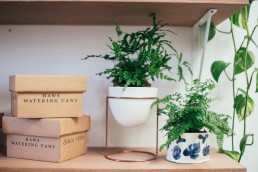
Since health, wellness and safety are the critical pillars for both individuals and institutions throughout the world, trends also point to empathy and flexibility being two skills that will be highly valued in designers. Nicholas Bloom, senior fellow at the Stanford Institute for Economic Policy Research, considers that working from home in unsuitable spaces has a negative effect in mental health and productivity.
Taking into consideration that the average size of an apartment in cities like Santiago, Mexico City, São Paulo, and Bogotá is between 50-60m2, the challenge for the designers of the region will be to create spaces that balance functionality with aesthetics for smaller apartments in order to have a positive effect in mental health.
It is not “one size fits all” for Latin American customers, well-being might have different approaches depending on the needs of the people living or working in certain spaces. Global trends such as efficiency in terms of materials (durable, easy to clean) recreating natural environments, and neutral tones might also be replicated in the region, however, it is more likely for designers to have small projects to incorporate better lightning, technological resources, and venting solutions than statement renovations.
Beyond the residential sector, corporate offices, and co-working spaces will also become a market opportunity for interior designers. Considering the stated design pillars, safety, and prevention must be the driver for inspiration: open spaces, high quality materials, and the “less is more” logic will prevail as workers come back.
Mental health will also be a top consideration when designing a space. Multipurpose rooms have to be harmonic and interior design techniques can be useful to reduce stress, anxiety and depression. Even though this trend is not new and there are several papers about the subject, it will regain importance since there are warnings about the emotional toll of the pandemic.
There are interesting opportunities for interior design professionals in the region to innovate whilst “going back to basics”. It will be a year to keep rethinking spaces, and learning how to stand out even though we might still need to stay in for a while.
María Mercedes Baltazar



